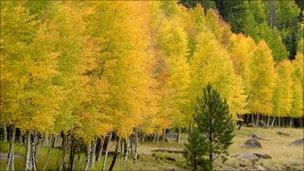Trees can't live forever without sex, study shows
- Published

Aspen cannot clone itself indefinitely. It must eventually reproduce sexually or die.
Certain trees are able to clone themselves, which raises the tantalising possibility that they could effectively "live forever".
But a study published in the journal PLoS Biology has dashed that hope.
Dr Dilara Ally and her team at the University of British Columbia, Canada, found that the fertility of clones declines with age.
This means that a tree cannot clone itself indefinitely; it must eventually sexually reproduce, or it will die.
The secret of eternal life has been sought by human alchemists for centuries, but certain trees were thought to have evolved the knack, through cloning.
As all keen gardeners know, many trees have the ability to clone themselves. Transplant a "leaf cutting" and up pops a genetically identical plant without the need for sexual reproduction.
In the wild, trees resort to cloning when there are no members of the same species nearby with which to sexually reproduce. It is a strategy that has helped them avoid extinction.
In the new study, Dr Ally and her team studied populations of trembling aspen to investigate the effects of cloning on tree fertility.
The aspen is particularly renowned for its ability to clone itself. Clones sprout from the roots and each is considered part of the same parent tree.
The single largest aspen clone - named Pando meaning "I spread" - is believed to be 80,000 years old and weighs 6,000 tonnes, which if confirmed would make it the world's oldest and heaviest organism.
Sex or Death
Dr Ally's team found that genetic mutations gradually build up with each subsequent generation of clone, resulting in a decline in fertility. This means that the aspen cannot clone itself indefinitely, but eventually must reproduce sexually or die.
The researchers used a novel "molecular clock technique" to work out the age of individual clones before measuring fertility.
This meant comparing the DNA of the clones to that of the parent to calculate the time since the clones first sprouted.
Prior to the advent of this method, clone age had to be determined by observing populations over long periods. With the aspen this would have been impractical.
"Imagine trying to follow cohorts of plants that live on average 100 years of age and don't start reproducing until they are 25; it's impossible within the timeframe of a PhD or even over an entire career," said Dr Ally.